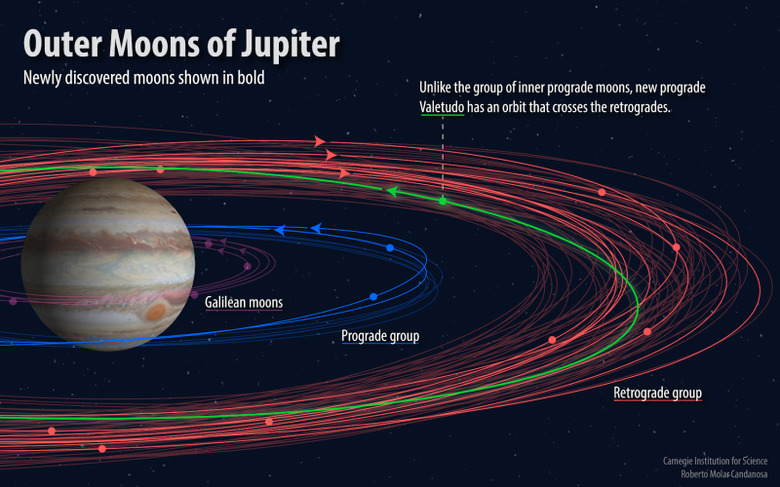Scientists Discover 12 New Jupiter Moons, Describe One As An "Oddball"
Jupiter, it's safe to say, is one of the marvels of our solar system. The planet is so absolutely massive that it has dozens of moons orbiting around it, by far the most of any of our neighboring planets. Up until recently, the total number of known satellites orbiting around Jupiter sat at 67, but now scientists with the Carnegie Institution for Science have announced the discovery of 12 new moons, bringing the total up to 79.
Of these 12 moons, Carnegie's Scott S. Sheppard – who led the team responsible for this discovery – describes 11 of these moons as "normal." The 12th and final moon, however, has instead been labeled an "oddball" by the team. The Institution gives the reasoning for these designations in an announcement on the Carnegie Science website.
Nine of the 12 moons are part of an outer group of satellites that orbit Jupiter in retrograde, which means that they orbit in the opposite direction of the planet's rotation. These moons take about two years to orbit Jupiter. Two of the 12, on the other hand, are found in a closer group that orbits Jupiter in prograde, which is the same direction of the planet's rotation. These moons take only a year to orbit Jupiter, which gives you an idea of how much distance separates the two groups.
So, what of this final "oddball" moon? This particular celestial body is strange for a couple reasons. The first is that it's small in size, with a diameter that totals only about a kilometer. The second is that it "has an orbit like no other known Jovian moon," Sheppard says. It has a prograde orbit like the closer group of moons, but during its trip around Jupiter, it crosses into the paths of those retrograde moons, resulting in an orbit that takes around one-and-a-half years to complete.

This, as you can imagine, has the potential to end poorly for our oddball friend and at least one of the other moons that are heading in the opposite direction. Sheppard describes this as "an unstable situation," noting that collisions between two moons are possible due to the 12th moon's strange orbit. "Head-on collisions would quickly break apart and grind the objects down to dust."
In fact, Sheppard and his team at Carnegie think that this moon could be all that's left of a previous collision in orbit around Jupiter. The proposed name for this new moon is Valetudo, who is the Roman goddess of health and hygiene and Jupiter's great-granddaughter. The hope is that these moons help us better understand the early days of our solar system, so we'll keep our fingers crossed for some interesting discoveries as they're researched further.
